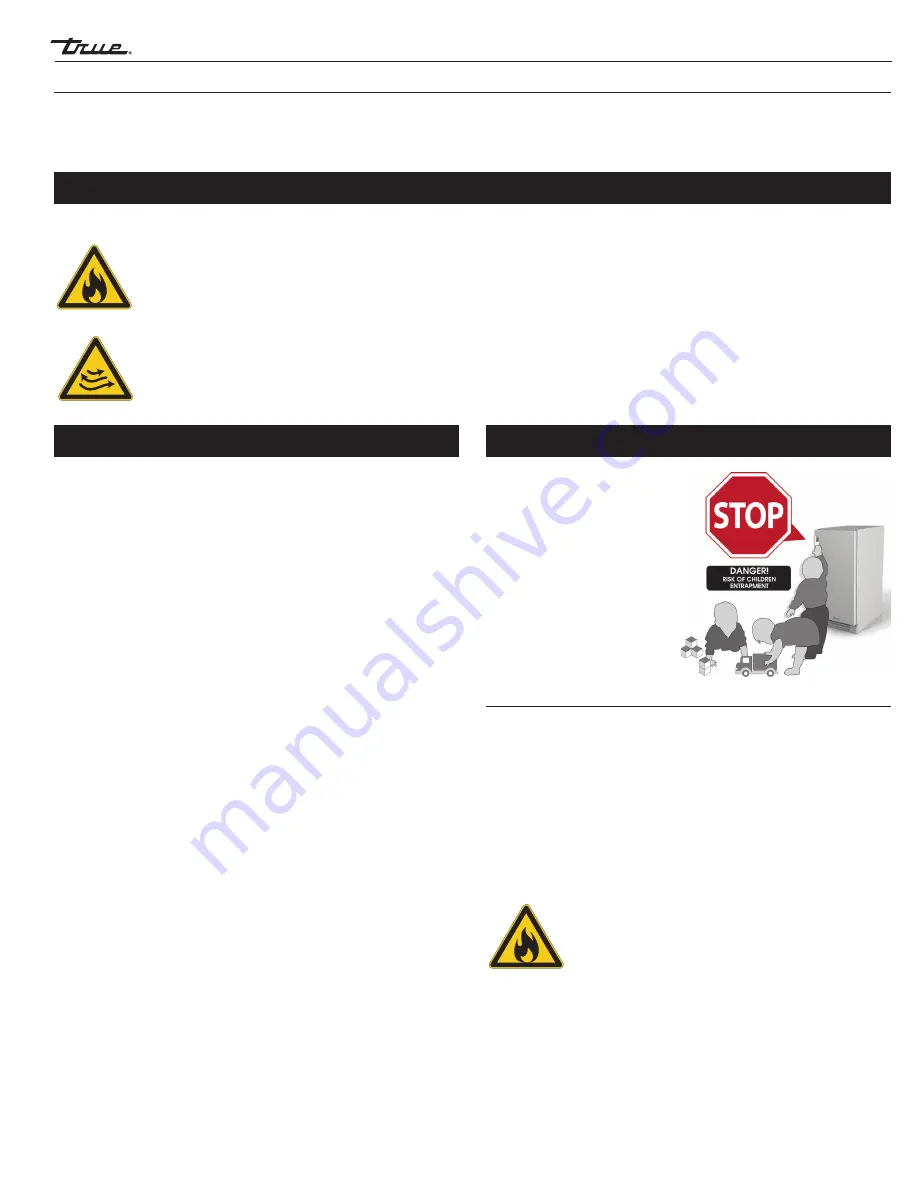
TRADITIONAL REACH-INS
TEC_TM_121 | REV. A | EN
03/3/2021
Page 3 of 22
truemfg.com
How to Maintain Your True Refrigerator to Receive the Most Efficient and Successful Operation
You have selected one of the finest commercial refrigeration units made. It is manufactured under strict quality controls with only the best
quality materials available. Your TRUE cooler, when properly maintained, will give you many years of trouble-free service.
WARNING
– Use this appliance for its intended purpose as described in this Installation Manual.
• Take care during operation, maintenance or repairs to avoid
cuts or pinching from any part/component of the cabinet.
• Units may pose a tipping hazard while uncrating, during
installation, or when moving the unit.
• Ensure the unit is properly installed and located in accordance
with the Installation Instructions before use.
• This appliance is not to be used, cleaned or maintained by
persons (including children) with reduced physical, sensory or
mental capabilities or lack of experience and knowledge, unless
they have been given supervision or instruction.
•
DO NOT
allow children to play with the appliance or climb,
stand, or hang on the unit's shelves to prevent damage to the
refrigerator and personal injury.
•
DO NOT
touch the cold surfaces in the freezer compartment
when hands are damp or wet. Skin may stick to these extremely
cold surfaces.
• Unplug the refrigerator before cleaning and making repairs.
• Setting temperature controls to the 0 position or powering
off an electronic control may not remove power from all
components (e.g., light circuits, perimeter heaters, and
evaporator fans).
•
DO NOT
store or use gasoline, or other flammable vapors and
liquids, in the vicinity of this or any other appliance.
•
DO NOT
store explosive substances such as aerosol cans with a
flammable propellant in this appliance.
• Keep fingers out of the “pinch point” areas; clearances between
the doors and cabinet are necessarily small; be careful closing
doors when children are in the area.
•
DO NOT
use electrical appliances inside the food storage
compartments of the units unless the appliances are of the
type recommended by the manufacturer.
NOTE:
All servicing must be performed by a qualified
technician.
See the serial label inside the cabinet for the units refrigeration type. For Hydrocarbon Refrigeration (R290 only), see below:
DANGER
– Risk of fire or explosion. Flammable refrigerant used.
DO NOT
use mechanical devices to defrost
refrigerator.
DO NOT
puncture refrigerant tubing; follow handling instructions carefully. To be repaired only by trained
service personnel.
DANGER
– Risk of fire or explosion (flammable refrigerant used), consult repair manual/owner’s guide before
attempting to service this product. All safety precautions must be followed. Dispose of properly in accordance with
local and federal regulations. Follow all safety precautions.
CAUTION
– Keep all ventilation openings clear of obstruction in the appliance enclosure or in the structure housing
the appliance.
DANGER!
RISK OF CHILD
ENTRAPMENT
Proper Disposal of the Cabinet
Child entrapment and suffocation are not problems of the past.
Junked or abandoned refrigerators are still dangerous, even if
they will sit for “just a few days.” If you are getting rid of your old
refrigerator, please follow the instructions below to help prevent
accidents.
Before throwing away your old refrigerator or freezer:
• Take off the doors.
• Leave the shelves in place so that children may not easily
climb inside.
DANGER
– Risk of fire or explosion. Flammable
insulation and/or refrigerant used. Dispose of all
in accordance with local and federal regulations.
Follow all safety precautions.
Cabinet Disposal Warning
Refrigerant Safety & Warning Information
Basic Safety & Warning Precautions



























